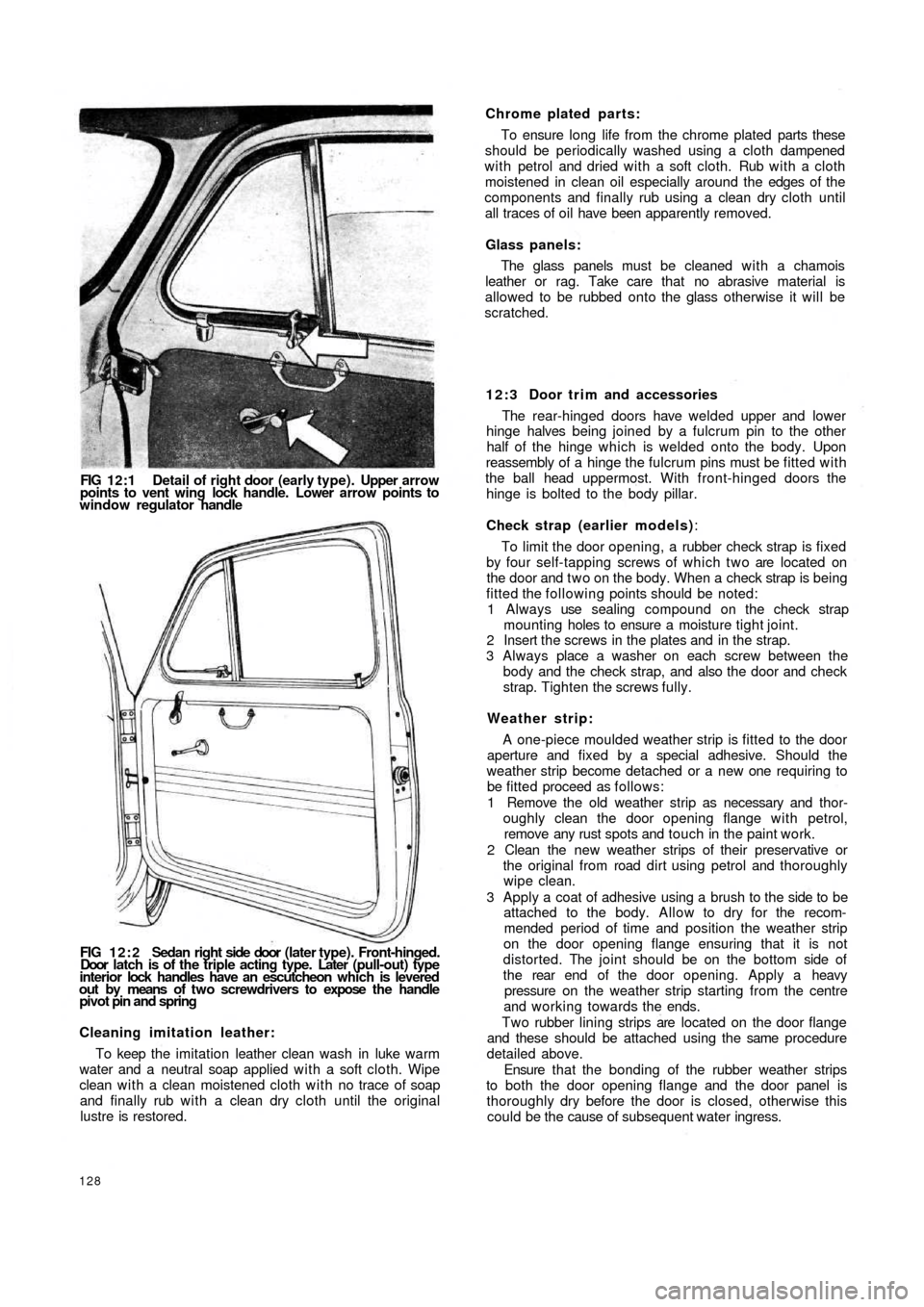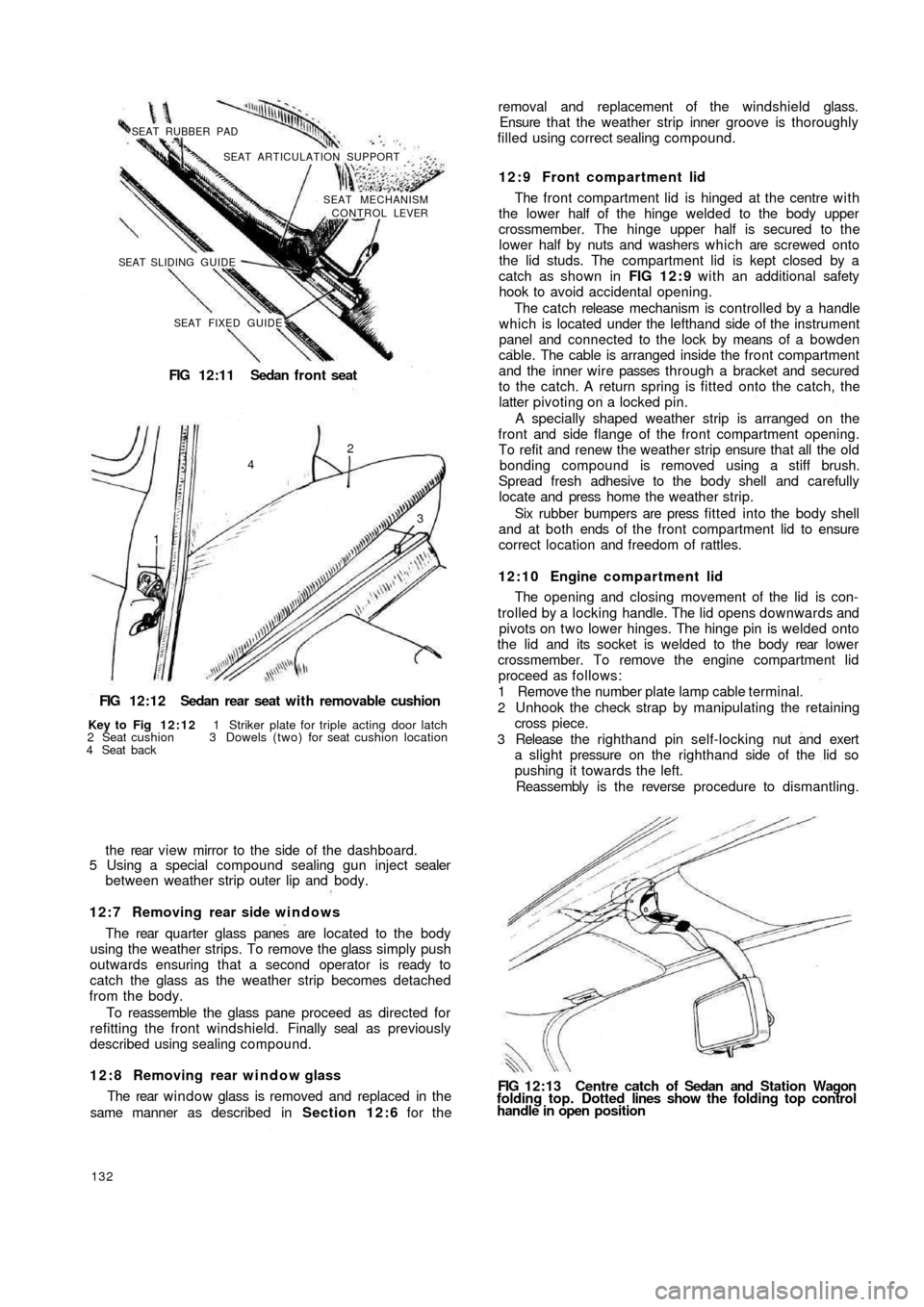tow FIAT 500 1967 1.G User Guide
[x] Cancel search | Manufacturer: FIAT, Model Year: 1967, Model line: 500, Model: FIAT 500 1967 1.GPages: 128, PDF Size: 9.01 MB
Page 121 of 128

FIG 12:1 Detail of right door (early type). Upper arrow
points to vent wing lock handle. Lower arrow points to
window regulator handle
FIG 1 2 : 2 Sedan right side door (later type). Front-hinged.
Door latch is of the triple acting type. Later (pull-out) type
interior lock handles have an escutcheon which is levered
out by means of t w o screwdrivers to expose the handle
pivot pin and spring
Cleaning imitation leather:
To keep the imitation leather clean wash in luke warm
water and a neutral soap applied with a soft cloth. Wipe
clean with a clean moistened cloth with no trace of soap
and finally rub with a clean dry cloth until the original
lustre is restored.
128
Chrome plated parts:
To ensure long life from the chrome plated parts these
should be periodically washed using a cloth dampened
with petrol and dried with a soft cloth. Rub with a cloth
moistened in clean oil especially around the edges of the
components and finally rub using a clean dry cloth until
all traces of oil have been apparently removed.
Glass panels:
The glass panels must be cleaned w i t h a chamois
leather or rag. Take care that no abrasive material is
allowed to be rubbed onto the glass otherwise it will be
scratched.
12:3 Door trim and accessories
The rear-hinged doors have welded upper and lower
hinge halves being joined by a fulcrum pin to the other
half of the hinge which is welded onto the body. Upon
reassembly of a hinge the fulcrum pins must be fitted with
the ball head uppermost. With front-hinged doors the
hinge is bolted to the body pillar.
Check strap (earlier models):
To limit the door opening, a rubber check strap is fixed
by four self-tapping screws of which two are located on
the door and t w o on the body. When a check strap is being
fitted the following points should be noted:
1 Always use sealing compound on the check strap
mounting holes to ensure a moisture t i g h t j o i n t .
2 Insert the screws in the plates and in the strap.
3 Always place a washer on each screw between the
body and the check strap, and also the door and check
strap. Tighten the screws fully.
Weather strip:
A one-piece moulded weather strip is fitted to the door
aperture and fixed by a special adhesive. Should the
weather strip become detached or a new one requiring to
be fitted proceed as follows:
1 Remove the old weather strip as necessary and thor-
oughly clean the door opening flange with petrol,
remove any rust spots and touch in the paint work.
2 Clean the new weather strips of their preservative or
the original from road dirt using petrol and thoroughly
wipe
clean.
3 Apply a coat of adhesive using a brush to the side to be
attached to the body. Allow to dry for the recom-
mended period of time and position the weather strip
on the door opening flange ensuring that it is not
distorted. The joint should be on the bottom side of
the rear end of the door opening. Apply a heavy
pressure on the weather strip starting from the centre
and working towards the ends.
Two rubber lining strips are located on the door flange
and these should be attached using the same procedure
detailed above.
Ensure that the bonding of the rubber weather strips
to both the door opening flange and the door panel is
thoroughly dry before the door is closed, otherwise this
could be the cause of subsequent water ingress.
Page 125 of 128

SEAT RUBBER PAD
SEAT ARTICULATION SUPPORT
SEAT MECHANISM
CONTROL LEVER
SEAT SLIDING GUIDE
SEAT FIXED GUIDE
FIG 12:11 Sedan front seat
42
3
1
FIG 12:12 Sedan rear seat w i t h removable cushion
Key to Fig 12:12 1 Striker plate for triple acting door latch
2 Seat cushion 3 Dowels (two) for seat cushion location
4 Seat back
t h e rear v i e w mirror to the side of the dashboard.
5 Using a special compound sealing gun inject sealer
between weather strip outer lip and body.
12:7 Removing rear side windows
The rear quarter glass panes are located to the body
using the weather strips. To remove the glass simply push
outwards ensuring that a second operator is ready to
catch the glass as the weather strip becomes detached
from the body.
To reassemble the glass pane proceed as directed for
refitting the front windshield. Finally seal as previously
described using sealing compound.
12:8 Removing rear window glass
The rear window glass is removed and replaced in the
same manner as described in Section 12:6 for the
132
FIG 12:13 Centre catch of Sedan and Station Wagon
folding top. Dotted lines show the folding top control
handle in open position removal and replacement of the windshield glass.
Ensure t h a t the weather strip inner groove is thoroughly
filled using correct sealing compound.
1 2 : 9 Front compartment lid
The front compartment lid is hinged at the centre w i t h
the lower half of the hinge welded to the body upper
crossmember. The hinge upper half is secured to the
lower half by nuts and washers which are screwed onto
the lid studs. The compartment lid is kept closed by a
catch as shown in FIG 1 2 : 9 with an additional safety
hook to avoid accidental opening.
The catch release mechanism is controlled by a handle
which is located under the lefthand side of the instrument
panel and connected to the lock by means of a bowden
cable. The cable is arranged inside the front compartment
and the inner wire passes through a bracket and secured
to the catch. A return spring is fitted onto the catch, the
latter pivoting on a locked pin.
A specially shaped weather strip is arranged on the
front and side flange of the front compartment opening.
To refit and renew the weather strip ensure that all the old
bonding compound is removed using a stiff brush.
Spread fresh adhesive to the body shell and carefully
locate and press home the weather strip.
Six rubber bumpers are press fitted into the body shell
and at both ends of the front compartment lid to ensure
correct location and freedom of rattles.
12:10 Engine compartment lid
The opening and closing movement of the lid is con-
trolled by a locking handle. The lid opens downwards and
pivots on two lower hinges. The hinge pin is welded onto
the lid and its socket is welded to the body rear lower
crossmember. To remove the engine compartment lid
proceed as follows:
1 Remove the number plate lamp cable terminal.
2 Unhook the check strap by manipulating the retaining
cross piece.
3 Release the righthand pin self-locking nut and exert
a slight pressure on the righthand side of the lid so
pushing it towards the left.
Reassembly is the reverse procedure to dismantling.